 About the gameboard:
The curved triangular playing board has 93 nodes (points of intersection) on which the black and white stones are played. There are 24 nodes along its 3 outside edges and 69 interior nodes. Each board side contains 9 nodes.
About the gameboard:
The curved triangular playing board has 93 nodes (points of intersection) on which the black and white stones are played. There are 24 nodes along its 3 outside edges and 69 interior nodes. Each board side contains 9 nodes.
Three of the interior nodes are pentads (connected to 5 other nodes); the other 66 are hexads (connected to 6 other nodes).
Each corner node "belongs" to both of its two adjacent sides.
Please check the individual game rules for how each game employs the board's features.
Aliens and Amazons
Differing objectives for two players, by Richard May
Start: One player (the Amazons) uses 30 black stones; the other (Aliens) uses just 3 white. Board empty.
Play: The players take turns placing one of their stones on any unoccupied node. White (the aliens) plays first. After all 3 white Aliens are on the board, they begin moving. The Amazons do not move until all 30 are on the board. While the Amazons are still being placed, they may be captured and removed from the board by being jumped over by Aliens.
Moving: Stones move one unit in any direction along lines to any unoccupied adjacent node. Amazons may not jump over other pieces, either Aliens or Amazons, and may not capture Aliens. An Alien may jump over an Amazon, if the node immediately on the other side of the Amazon on the same straight line is unoccupied, and the jumped-over Amazon is removed from the board. Multiple jumps and captures of Amazons by an Alien are allowed. Capturing is not mandatory. Aliens may also jump over other Aliens but without capturing them.
Goals The object of the Amazons (Black) is to block and immobilize the three white Aliens, thereby winning the game. The object of the Aliens (White) is to capture a sifficient number of Amazons to eliminate the possibility of being blocked and immobilized, thereby winning the game.

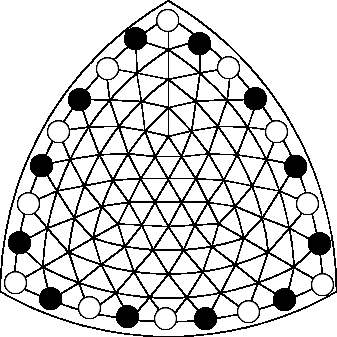 Singularity
Singularity
Reduction by fusion
Start: 12 stones of their own color for each player, arranged alternating around the perimeter of the board as shown.
Play: Taking turns, players move any one of their stones by 1, 2 or 3 unit spaces along an unobstructed line, in any direction. A stone may move in only a single direction on a turn. There are no jumps and no captures of opponent pieces. When a player's stone lands immediately next to a stone of its own color, in any direction, on or within the 15 nodes of the central triangular region of the board (outlined in figure below),
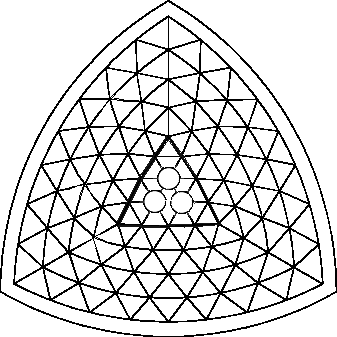 the moving stone captures the resting stone, which is removed from the board. Only one stone may be removed on a turn. A player's stones may be used to block the movement of opponent stones. A player may not occupy more than one of the 3 central nodes of the board at the end of a turn.
the moving stone captures the resting stone, which is removed from the board. Only one stone may be removed on a turn. A player's stones may be used to block the movement of opponent stones. A player may not occupy more than one of the 3 central nodes of the board at the end of a turn.
Goal: To be the first player to have only one stone remaining on the board, occupying one of the 3 central nodes.

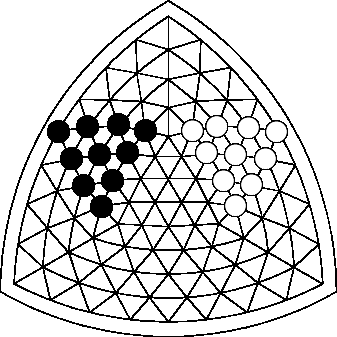 Leap Over
Leap Over
A jumpy modified Chinese Checkers game by Kate Jones
Start: 10 stones of their own color for each player on the triangular sections whose point is the center of a side of the board, as shown at left.
Play: Take turns jumping any one of your stones over another stone directly next to it, to an empty intersection immediately on the other side of the stone being jumped, on the same straight line from which the jump began. A stone may jump over stones of either color, in any direction on the board, and over more than one stone, as long as it touches down after each one. The jumping stone may change direction at the end of any one leap in a series. Stones on the outer edge of the board can be jumped over only by stones also on the outer edge.
Jumps over stones at the center of any "pentagon" may follow either fork on the other side of the pentagon. Every move must be a leap.
Goal: To be the first player to move all stones into the opponent's start position.

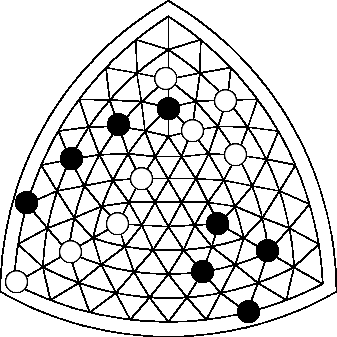 Tetra
Tetra
Stretched formations of fours, by Richard May
Start: Gameboard empty; players each use 10 stones of their own color.
Play: Players take turns placing one of their stones on any unoccupied node of the board, until one player achieves the goal or until all stones are played out. If neither player wins during this placement phase, the game continues into the movement phase.
Moving: Players take turns moving one of their stones to an unoccupied node either one or two units distant along an unobstructed line, in any of the six directions, until one player wins. Moves through a pentagon may follow either fork.
Goal: To form four pieces into either a straight line or a diamond-shaped pattern on alternate rows, shown above. Note that a winning figure is formed by non-adjacent stones that are separated by either lines or nodes. The interior nodes of a figure may be occupied by other stones of either color. Patterns can thus occur in mutually embedded positions.

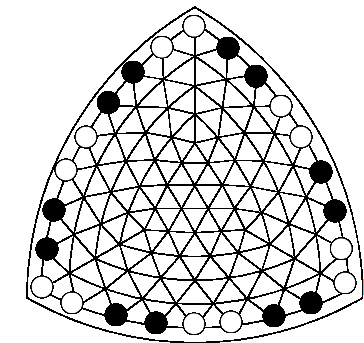 Quinta
Quinta
Alignment game suggested by Christopher Clark
Start: 12 stones of their own color for each player, arranged in pairs around the board as shown at left.
Play: Players take turns moving one of their stones any distance along an unobstructed line, in any direction, to an unoccupied node. Through the 3 pentagons movement may follow either fork.
Goal: To be the first player to link up 5 adjacent stones on the same line. Here are some sample winning positions:
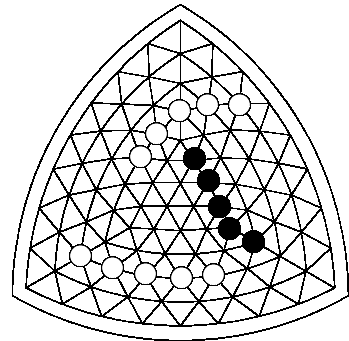

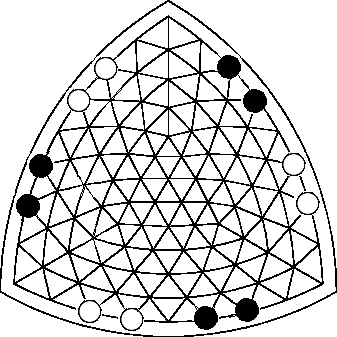 Sexta
Sexta
Line-of-6 strategy game
Start: 6 stones for each player of their own color, arranged on the perimeter of the board as shown at left.
Play: Players take turns moving any one of their stones any distance along an unobstructed line, in any direction. Movement through a pentagon may follow either of the two forks that exit on the other side.
Goal: To be the first player to form a line of six adjacent stones. The line need not be straight as long as no stone has more than two neighbors. Some sample wins are shown here:
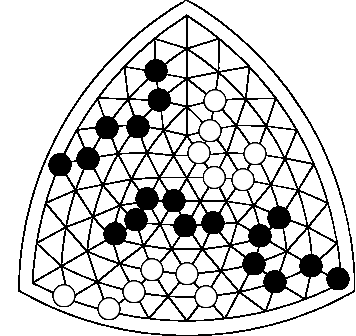

| 
 About the gameboard:
The curved triangular playing board has 93 nodes (points of intersection) on which the black and white stones are played. There are 24 nodes along its 3 outside edges and 69 interior nodes. Each board side contains 9 nodes.
About the gameboard:
The curved triangular playing board has 93 nodes (points of intersection) on which the black and white stones are played. There are 24 nodes along its 3 outside edges and 69 interior nodes. Each board side contains 9 nodes. Singularity
Singularity the moving stone captures the resting stone, which is removed from the board. Only one stone may be removed on a turn. A player's stones may be used to block the movement of opponent stones. A player may not occupy more than one of the 3 central nodes of the board at the end of a turn.
the moving stone captures the resting stone, which is removed from the board. Only one stone may be removed on a turn. A player's stones may be used to block the movement of opponent stones. A player may not occupy more than one of the 3 central nodes of the board at the end of a turn. Leap Over
Leap Over Tetra
Tetra Quinta
Quinta
 Sexta
Sexta